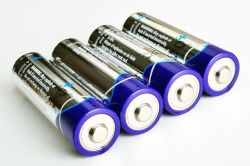What is the capacity of a R6 AA 1.5V alkaline battery?
Can a battery "have amps"? We can correctly say the capacity in ampere-hours or the maximum current that an alkaline battery can generate, this current depends on its internal resistance. The internal resistance of a cell will depend on the type of cell and the degree of discharge and temperature. For a fresh R6 zinc carbon cell, the internal resistance will be greater (i.e. maximum current lower) than for an LR6 alkaline cell (approximately 0.2?-0.3?  . A fresh L91 / FR6 lithium cell will have lower resistance (approximately 0.1?-0.2?
. A fresh L91 / FR6 lithium cell will have lower resistance (approximately 0.1?-0.2?  than the alkaline cell. An additional feature of FR6 cells is their lower mass than LR6 and longer storage period without loss of properties.
than the alkaline cell. An additional feature of FR6 cells is their lower mass than LR6 and longer storage period without loss of properties.
From practice I will add that the useful instantaneous current of an LR6 (AA) alkaline cell with a voltage drop to about 1V can be as high as 2A-4A. For an AAA alkaline cell, it will be 1-1.5A for the same conditions.
An important parameter of galvanic cells is the capacity expressed in Ah (or Wh), the capacity depends on how long we will be able to draw current from the cell with a certain intensity. How do you imagine what an ampere hour is?
The capacity of AA cells can reach:
-R6 1Ah,
-LR6: 2Ah,
-FR6: 3Ah.
Examples of manufacturers' catalog data:
L91 lithium cell: https://data.energizer.com/PDFs/l91.pdf
LR6 alkaline cell: https://data.energizer.com/pdfs/alk-power-aa.pdf
From practice I will add that the useful instantaneous current of an LR6 (AA) alkaline cell with a voltage drop to about 1V can be as high as 2A-4A. For an AAA alkaline cell, it will be 1-1.5A for the same conditions.
An important parameter of galvanic cells is the capacity expressed in Ah (or Wh), the capacity depends on how long we will be able to draw current from the cell with a certain intensity. How do you imagine what an ampere hour is?
The capacity of AA cells can reach:
-R6 1Ah,
-LR6: 2Ah,
-FR6: 3Ah.
Examples of manufacturers' catalog data:
L91 lithium cell: https://data.energizer.com/PDFs/l91.pdf
LR6 alkaline cell: https://data.energizer.com/pdfs/alk-power-aa.pdf




Comments
R20 - 5Ah or more. Two primary or secondary cells form a battery. When the cells are connected in parallel, the resistance of the battery decreases (the conductivities of the individual cells add up).... [Read more]
I met with R20 parallel connection in spark gaps for gas flow water heaters, maybe it was about reducing the internal resistance of such a set? [Read more]
This is. The current transferred to the load increased and the capacity increased. [Read more]
I don't understand what the purpose of this article is. All this information is available and rather self-explanatory. It's like rediscovering Ohm's Law. [Read more]
For people who systematically learned electronics / electrical engineering, yes. But take into account that there are electronics enthusiasts among teenagers, they don't have an electrical engineering... [Read more]
Unfortunately, I only have access on the phone and I will not make a table. Pensanic with some pocket weight. In a few other cases, the Rw could also be up to 2 ohms with some free batteries, the rest... [Read more]
What is this article supposed to represent? The engineer should be data driven. So in this case on tests or catalog notes, and not on your "whim". [Read more]
See in which section this article is placed. Beginner Electronics I think it might be useful to them, although the article is very sketchy. It would be worth, for example, to write more about... [Read more]
@Cockroach the more there should be a reference to some catalog note. Let beginners educate themselves to check component parameters, not to copy mindlessly. For example, the Varta Industrial LR6 battery... [Read more]
In addition, sample manufacturer's catalog data: L91 lithium cell: https://data.energizer.com/PDFs/l91.pdf LR6 alkaline cell: https://data.energizer.com/pdfs/alk-power-aa.pdf Did you know that... [Read more]
I am asking the author for forgiveness, but in my humble opinion there is a basic error in the title of the thread ... What does it mean "How many amps have a battery"? A mistake in the vocabulary, because... [Read more]
Do you know what you are talking about ??? [Read more]
This is something similar to the question of how many Hertz a TV has. I know. They must be locked inside somehow. [Read more]
Robert B -> And what was I supposed to write about in the post above? [Read more]
The beginner's question about the possibilities of cells usually sounds like this topic ... I am fully aware that the battery "has no amps" and the socket "has no Hertz" :) and the title of the material... [Read more]
Well, I don't know ... You didn't convince me. The search for a phrase can also be in the text, not only in the subject. And because (as it still seems to me) we are on the technical forum - the... [Read more]
Neither do I. And that is why I agree with the opinion of long-term users that Elektroda descends on dogs (including such titles of "articles"). [Read more]
Everyone has an opinion and that's it the title of the material attracted people who expanded the content of the material with their posts, which is very beneficial. From my point of view, the discussion... [Read more]
And it's not easier to correct the question (preferably in two) 1. What is the current efficiency of the cell? - that is, how many useful amps will flow to the receiver (and here we take into account... [Read more]